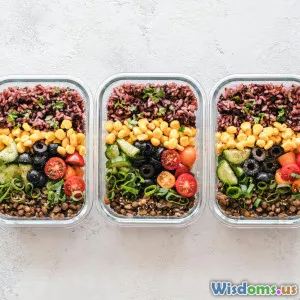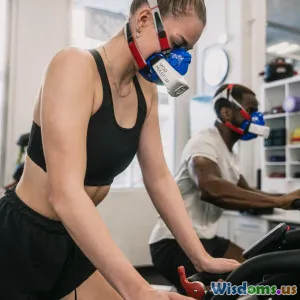
A Deep Dive into Hydration Tactics Before and After Exercise
7 min read Explore effective hydration tactics before and after exercise to boost performance and recovery in this detailed sports science guide. (0 Reviews)
A Deep Dive into Hydration Tactics Before and After Exercise
Hydration isn't just about quenching thirst—it's a finely tuned science crucial for athletic performance, endurance, and recovery. Yet, many athletes and fitness enthusiasts underestimate the impact of proper fluid intake surrounding their workouts. Whether you're a marathon runner, weightlifter, or weekend warrior, understanding the nuances of hydration before and after exercise can propel your physical capabilities and accelerate recovery times.
In this comprehensive article, we'll explore hydration tactics grounded in sports science. We'll explain why timing, fluid type, and quantity matter, supported by real-world research and expert insights to help you make smarter hydration choices.
Understanding Hydration’s Role in Exercise
Water comprises approximately 60% of the human adult body, underscoring its vital role in physiological functions. During exercise, the body loses fluids primarily through sweating to regulate core temperature. According to the American College of Sports Medicine (ACSM), even a 2% loss in body weight due to dehydration can impair athletic performance significantly.
Key performance aspects affected by hydration include:
- Cardiovascular function: Dehydration lowers blood volume, forcing the heart to work harder to pump blood and deliver oxygen.
- Thermoregulation: Fluid loss compromises the body's ability to sweat and cool itself, increasing the risk of heat-related illnesses.
- Muscle function: Electrolyte imbalance from fluid loss can lead to cramps and reduced muscle contraction efficiency.
In aggregate, proper hydration optimizes endurance, strength, and cognitive functions—all essential for sustained physical activity.
Hydration Tactics Before Exercise
Timing is Everything
Hydrating before exercise isn’t about gulping down large amounts just before starting. It requires measured, well-timed intake:
-
2 to 3 hours before exercise: Aim to drink 5 to 7 mL of water per kilogram of body weight. For a 70 kg person, this means roughly 350-490 mL (12-17 ounces). This window allows adequate absorption and prevents discomfort.
-
15 to 20 minutes before exercise: Consume another 200-300 mL (7-10 ounces) to top off hydration levels.
Choose the Right Fluids
Plain water is effective for most, but for prolonged or intense workouts (longer than 60 minutes), consider a beverage containing electrolytes—especially sodium and potassium—because they help maintain fluid balance and nerve/muscle functions.
Example: A 2018 study in the Journal of Athletic Training found that athletes consuming electrolyte-enhanced beverages pre-exercise reported better endurance and less perceived exertion compared to plain water.
Avoid Overhydration
Drinking excessive amounts can lead to a rare but dangerous condition called hyponatremia, where blood sodium becomes diluted. Therefore, listen to your body, avoid forced consumption, and aim for balance.
Hydration Tactics During Exercise
Understanding hydration before and after exercise is pivotal, but what about during activity? Here are critical insights:
-
If exercising less than 60 minutes at moderate intensity, small sips of water are adequate.
-
For exercises lasting longer, use sports drinks with 6-8% carbohydrate concentration to provide energy and electrolytes.
Cornell researcher Coggan (2014) suggests sipping 150-250 mL of fluid every 15-20 minutes during prolonged exercise to maintain hydration and performance.
Hydration Tactics After Exercise
The Recovery Window
Post-exercise hydration kicks off the recovery process. The body must replace lost fluids, electrolytes, and repair muscle tissue:
- Start rehydrating immediately after stopping.
- Quantify hydration using body weight changes. To offset sweat loss, consume about 150% of the fluid lost. Meaning, if you lost 1 kg (about 2.2 lbs) during exercise, drink 1.5 liters of fluid.
Electrolyte Replacement
Sweat contains sodium, chloride, potassium, magnesium, and calcium. Sodium is the most critical to replace because it helps retain ingested fluids and maintains plasma volume.
Commercial recovery drinks or natural sources like coconut water, which contains potassium and sodium, can be effective.
Real-World Insights and Expert Tips
Legendary ultramarathoner Scott Jurek emphasizes personalized hydration, stating, “Hydration strategies must fit the individual’s sweat rate, electrolyte loss, and the environmental conditions.” Coaches recommend sweat testing as a tool to tailor hydration plans.
In a 2020 study from the International Journal of Sports Nutrition and Exercise Metabolism, customized hydration plans reduced cramping and heat illnesses in collegiate athletes by 30%, highlighting the importance of an individualized approach.
Conclusion
Hydration before and after exercise is more than a simple practice—it's a science that influences performance and recovery profoundly. By timing fluid intake strategically, selecting appropriate beverages, and monitoring individual needs via sweat rates and body weight, athletes can unlock better endurance, reduce injury risk, and enhance overall health.
Whether you’re preparing for an intense workout or winding down afterward, understanding and applying effective hydration tactics is essential. Start today: calibrate your hydration plan to your body’s demands and elevate your athletic journey with science-backed hydration.
References
- American College of Sports Medicine. (2007). Exercise and fluid replacement.
- Journal of Athletic Training, 2018.
- Coggan, A. R. (2014). Fluid and carbohydrate intake during prolonged exercise.
- International Journal of Sports Nutrition and Exercise Metabolism, 2020.
Empower your performance with knowledge—hydrate smart, train smarter.
Rate the Post
User Reviews
Popular Posts


















